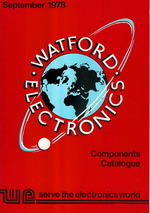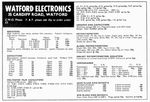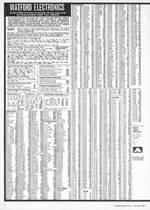The legacy of Watford Electronics Ltd.
Back in the heady electronics hobbyist days of the 1970s and 1980s, constructors who sought mail order suppliers of components were spoilt for choice. UK hobby magazines of the era, like Practical Electronics, Practical Wireless or Everyday Electronics (all published by IPC Magazines then), were stuffed with adverts for a myriad of independents including Watford Electronics, a small firm established in 1972 to serve the electronics hobbyist.
This article is a tribute to Watford Electronics’ journey from its humble beginnings to greatness.
 1978 Catalogue image showing the shop at 33/35 Cardiff Road, WatfordWatford's price lists often filled magazine pages with advertising and the firm had a small shop at 33/35 Cardiff Road, Watford. Thanks to Google Street View we can now browse a decade’s worth of street scenery where we see how the original crazy-paved shop window (see 1978 catalogue) was still there in 2008 before being removed in 2009 onwards. Funny how full-page magazine adverts made suppliers look big. See https://goo.gl/maps/iDrjE8NpfNn In the latest Street View photos, if you zoom out an aerial view is adopted and outbuildings in the back yard can be seen. Perhaps they were the original Watford Electronics office or store.
1978 Catalogue image showing the shop at 33/35 Cardiff Road, WatfordWatford's price lists often filled magazine pages with advertising and the firm had a small shop at 33/35 Cardiff Road, Watford. Thanks to Google Street View we can now browse a decade’s worth of street scenery where we see how the original crazy-paved shop window (see 1978 catalogue) was still there in 2008 before being removed in 2009 onwards. Funny how full-page magazine adverts made suppliers look big. See https://goo.gl/maps/iDrjE8NpfNn In the latest Street View photos, if you zoom out an aerial view is adopted and outbuildings in the back yard can be seen. Perhaps they were the original Watford Electronics office or store.
 Feeling in a nostalgic frame of mind, I have scanned the entire Watford Electronics 1978 catalogue which gives a good feel for the state of the hobbyist art at that time. It starts with more than a dozen pages of transistor data and the usual crop of discrete parts and TTL and CMOS logic chips. A page of linear ICs and op.amps precedes more pages of discrete components, followed by switches, tools and much more. A contemporary hobby electronics builder would have possessed all the necessary skills to understand and utilise these types of parts in their projects. (Tip: right-click the links and Save As...)
Feeling in a nostalgic frame of mind, I have scanned the entire Watford Electronics 1978 catalogue which gives a good feel for the state of the hobbyist art at that time. It starts with more than a dozen pages of transistor data and the usual crop of discrete parts and TTL and CMOS logic chips. A page of linear ICs and op.amps precedes more pages of discrete components, followed by switches, tools and much more. A contemporary hobby electronics builder would have possessed all the necessary skills to understand and utilise these types of parts in their projects. (Tip: right-click the links and Save As...)
Download the 1978 Watford Electronics catalogue Part One
Download the 1978 Watford Electronics catalogue Part Two
I am guessing that the entire Watford Electronics catalogue was probably typed and laid out by hand, possibly using an IBM golfball typewriter (I recognise the typeface) but I might be wrong. It would have been an enormous clerical and typesetting task at the time either way.
 Watford 1973 advert in Practical Electronics [click to see]
Watford 1973 advert in Practical Electronics [click to see]
Some Watford milestones
Apart from retailing components, amongst other achievements Watford claimed to introduce the UK’s first TV game ‘Pong’ in 1976 and I recall a series of LSI chips produced by GI (General Instruments) for simple video games that proved a bit buggy. Notable too was Watford’s use of the new-ish Intersil 7106 chip at the heart of a new digital multimeter kit, the Watford DM900, at a time when digital test meters were pretty rare and expensive. It was state of the art stuff in the 1970s when most of us had South Korean moving coil or Russian-made moving iron multimeters, or very expensive Avo 8 multimeters.
Watford Electronics also offered a kit for the Practical Wireless “Purbeck” cathode ray oscilloscope (1978) and kits for the Practical Electronics Rhythm Generator (1978). A new design for an Electronic Piano was also floated and promised for 1979 (page 64).
Of huge interest to me were their Figaro TGS gas sensors (page 66), and Watford Electronics supplied numerous components for my Gas Sentinel and multichannel gas detector as featured in Everyday Electronics at the time. EE did me proud when they published those, and they were very successful amateur projects.
Much of Watford’s product range was standard hobby electronics fare that typified what was on offer by mail order to customers at the time. No credit card processing existed: you filled in a form, calculated it manually and posted it off with a cheque or money order (page 2). Furthermore, there were two rates of VAT (GST), 12½% or 8% which created total bureaucratic nightmares.
 Full page advert, November 1981 Practical Electronics [click to open]The firm would gradually diversify away from penny resistors when Watford caught the tide of home computing that was breaking in the 1980s. They majored on the Sinclair Spectrum, BBC and Acorn computers and all the peripherals, consumables and cables etc. that went with them. The business plan would be obvious: "added value" was a business buzz-word in the 1980s and Watford Electronics could add more value to electronics kits and products of their own (Maplin was doing the same) than selling penny components. They went on to design a memory module for the BBC home computer before launching their own 286 laptop computer.
Full page advert, November 1981 Practical Electronics [click to open]The firm would gradually diversify away from penny resistors when Watford caught the tide of home computing that was breaking in the 1980s. They majored on the Sinclair Spectrum, BBC and Acorn computers and all the peripherals, consumables and cables etc. that went with them. The business plan would be obvious: "added value" was a business buzz-word in the 1980s and Watford Electronics could add more value to electronics kits and products of their own (Maplin was doing the same) than selling penny components. They went on to design a memory module for the BBC home computer before launching their own 286 laptop computer.
Watford Electronics would prove a very progressive and motivated company and they opened their first dedicated computer store in 1982, which I assume was the one named Jessa House, 250 Lower High Street, Watford that appeared in advertising at the time.
This old Watford catalogue cover turned up at the Centre for Computing History along with a comprehensive list of Watford's software.
At the time of writing, this building houses an educational supplies establishment ‘Junior Scholars’, captured on Google Street View here since at least 2008. It turns out the building is just a stone’s throw from WE’s first electronics shop located on Cardiff Road, Watford shown on the ‘78 catalogue above.
Remember that home computing was fast becoming a hobby in its own right which rivalled electronics, as reflected by the (our) magazine’s name change from Everyday Electronics to Everyday Electronics and Computer Projects from the May 1983 issue. To be honest, I then completely lost interest in the magazine for a good few years. I wasn’t interested at all in home computing hardware until the early 90s when I bought a PC for use in word processing but not for doing engineering with.
Watford's Aries PC systems
Racing ahead, Watford would continue to evolve into a system builder and integrator with their own computer brand: Aries. Online sales were hosted under Watford.co.uk at this time, and their green stripey-bordered adverts were familiar in computer magazines, selling all manner of computing and electronics. The evolving home computer market would become extremely volatile due to razor-thin margins in a volume market. The only way to make money was to shift lots of product, and they faced formidable and ruthless competition from major players such as Dell, HP and Fujitsu who all enjoyed economies of scale.
A number of major casualties, PC brands that were very familiar at the time, fell by the wayside. Watford managed to acquire other brands (Carrera for one, and Time and Tiny Computers in 2005). The 2000’s is littered with the names of many defunct system builders and Watford would itself eventually suffer the same fate: the market for independent system builders gradually just got eaten away.
In 1992 Watford had opened a custom-built HQ and second store in Luton. Watford Electronics would go on to rebrand itself online as Savastore then Saverstore. This Savastore catalogue/ advert from 2004 shows a diverse range of ICT goods for sale - right click and Save As... [download PDF].
 Jessa House, Watford's main HQ (2012, click to see) (Image: Google)By 2007 Watford.co.uk redirects to savastore.co.uk, selling a huge range of computer and IT equipment online from its HQ at 1 Finway, Luton. The shape of this building would become familiar to many computer enthusiasts in computer magazine adverts. ‘Jessa House’ at 1, Finway was a glassy building as shown in Google here (2009) – note the Jessa House plinth by the roadside in 2012, which has overgrown by 2015 and after seeing better days seems to be near a car wash. The glass atrium still displays ‘Jessa House’ above the door, and Watford's Aries logo is still up on the building at 2015. The Jessa House plaque on the plinth has been ripped off by 2020 and the block looks tired and unkempt, a shadow of the heady days.
Jessa House, Watford's main HQ (2012, click to see) (Image: Google)By 2007 Watford.co.uk redirects to savastore.co.uk, selling a huge range of computer and IT equipment online from its HQ at 1 Finway, Luton. The shape of this building would become familiar to many computer enthusiasts in computer magazine adverts. ‘Jessa House’ at 1, Finway was a glassy building as shown in Google here (2009) – note the Jessa House plinth by the roadside in 2012, which has overgrown by 2015 and after seeing better days seems to be near a car wash. The glass atrium still displays ‘Jessa House’ above the door, and Watford's Aries logo is still up on the building at 2015. The Jessa House plaque on the plinth has been ripped off by 2020 and the block looks tired and unkempt, a shadow of the heady days.
 Savastore 2005 website screenshot [click to see]
Savastore 2005 website screenshot [click to see]
 Watford's rebranded Saverstore website 2007 [click to see]In the late 90’s Watford had envisaged opening a chain of retail stores including ‘six or seven superstores’, trade sources said at the time. By 2000 Saverstore was turning over £30 million of IT and consumer electronics, but by 2006 the storm clouds were gathering and the system integrator was struggling under some perverse market conditions, no doubt feeling the pressure from large rivals in the PC market who designed and built their own systems. In response, Watford launched a brand called RedTen Internet that offered a PC and broadband/ ISP bundle which trade sources say never reached its potential.
Watford's rebranded Saverstore website 2007 [click to see]In the late 90’s Watford had envisaged opening a chain of retail stores including ‘six or seven superstores’, trade sources said at the time. By 2000 Saverstore was turning over £30 million of IT and consumer electronics, but by 2006 the storm clouds were gathering and the system integrator was struggling under some perverse market conditions, no doubt feeling the pressure from large rivals in the PC market who designed and built their own systems. In response, Watford launched a brand called RedTen Internet that offered a PC and broadband/ ISP bundle which trade sources say never reached its potential.
In 2007, in a shock move, the Saverstore business was sold, on paper anyway, in a management buyout to Globally Ltd. which had sprung up just a few days earlier at the same address. Mystery surrounded the deal at the time and Globally Ltd. was tight-lipped about the buyout. Records now show a Debenture favouring a likely backer which presumably provided finance to Globally Ltd. secured by the charge over Watford’s assets. In 2008 Globally Limited changed names to Online Distribution Limited t/a Saverstore.com.
So Long, Saverstore
Trading remained challenging and competition from multinational system builders like Dell and HP must have been intense. Something was afoot when in 2015 a finance arrangement was entered into by way of another Debenture, as recorded at Companies House. The Saverstore website continued until it finally went off air in early 2017. On 17th May 2017 a winding up petition was made against Online Distribution Limited and the firm was finally dissolved altogether on 15th June 2018.
This sorry conclusion came nearly half a century after Watford Electronics’ roots were founded as a small mail order supplier of components located in the back streets of Watford, serving amateur constructors nationally during those, the best days of hobby electronics. It was a respected brand offering a good service but, like rival Maplin Electronics, ultimately could not compete with fierce competition, a maturing market and changing buyers' habits.
In 2022 I was contacted by a former staff member at Watford who gives an insight into what it was really like in those early days, and I've recounted his tale here.
Also see
- http://www.alanwinstanley.com/alan-winstanleys-journal/2017/7/7/saverstorecom-lights-out.html
- Watford Electronics advert in Practical Electronics, 1981 (PDF)
- Maplin Electronics: the long farewell


 Sunday, July 15, 2018 at 3:41PM
Sunday, July 15, 2018 at 3:41PM
Reader Comments (4)
I have fond memories of Watford Electronics having purchased my first Antex X25 soldering iron from them as a teenager by mailorder from NZ in the 1970s. Later, having moved to Australia and graduated from university in the early 1980s I again dealt with them by mailorder from Australia to buy 6x 2114 static RAM chips to make a 3K memory expander for my VIC-20 computer. Ahh, the nostalgia...
I too remember Watford Electronics with great affection, as a kid I mail ordered 555 timers, breadboards and all that sort of stuff from them. I still use the Breadboard to this day, but it has an Arduino plugged into it now.
I also brought one of their 'Ares' computer systems in my 20's, a Pentium 120 (eg 120 Mhz.. my watch runs a more powerful CPU these days..), it got used as a freebsd server in the early 2000's
Thank you very much for this article, it brought a warm fuzzy feeling all over.!
Thanks for this article. I used to ride my bike from my home in Abbots Langley into Watford to Watford Electronics to spend my pocket money on components. It was the highlight of the week and I couldn't wait to get back to complete my projects. I remember the shop was always busy (certainly at weekends anyway!) and I enviously eyed up the expensive computer equipment well beyond my small budget. Very happy memories from the late 70's.
Thanks Ian. Nostalgia isn't what it used to be :)